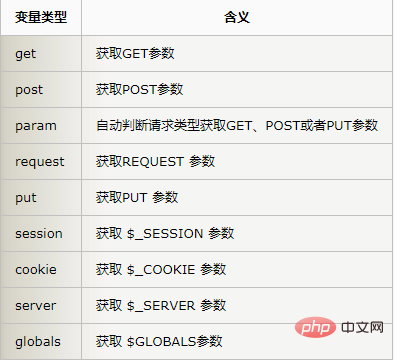Home >PHP Framework >ThinkPHP >How to use tinkphp capital letter function
How to use tinkphp capital letter function
- 爱喝马黛茶的安东尼Original
- 2019-08-22 09:35:502382browse

##ThinkPHP capital letter function summary:
A method
A method is used to instantiate the controller internallyCalling format: A('[project://][group/]module','controller Layer name') The simplest usage:$User = A('User');means instantiating the UserAction controller of the current project (the file corresponding to this controller is located in Lib/Action/UserAction.class.php), If the group mode is adopted and you want to instantiate another Admin grouped controller, you can use:
$User = A('Admin/User');also supports cross-project instantiation (the project directories must remain at the same level)
$User = A('Admin://User');means Instantiate the UserAction controller under the Admin project 3.1 version adds support for hierarchical controllers, so you can also use the A method to instantiate other controllers, for example:
$User = A('User','Event);Instancing UserEvent controller (the corresponding file is located in Lib/Event/UserEvent.class.php). After instantiating a controller, you can call methods in the controller. However, what needs to be noted is that when calling across projects, if your operation method has special variables for the current controller There will be some unknown problems in operation, so generally speaking, officials recommend that the controller layer that requires public calls be developed separately without too many dependencies.
B method
This is a new function that comes into being with the behavior and can perform a certain behavior. For example,B('app_begin');is at the beginning of the project Before, all functions defined by this behavior are executed. Supports 2 parameters, the second parameter needs to accept an array, for example
B('app_begin',array("name"=& gt;"tdweb","time"=>time()));
C method
C method is used by ThinkPHP to set, get, and save configuration The parameter method is used more frequently. To understand the C method, you need to first understand the configuration of ThinkPHP, because all operations of the C method are related to the configuration. ThinkPHP's configuration file is defined in PHP array format. Due to the function overloading design, there are many usages. Let’s explain them one by one. Set parametersC('DB_NAME','thinkphp');means setting the value of the DB_NAME configuration parameter to thinkphp. Since the configuration parameters are not case-sensitive, the following writing is the same:
C('DB_NAME','thinkphp');But it is recommended to keep it Uniformly capitalized configuration definition specifications. All parameters of the project can be dynamically changed through this method before taking effect. The last set value will overwrite the definition in the previous settings or conventional configuration. You can also use the parameter configuration method to add new configurations. Supports the setting of secondary configuration parameters, for example:
C('USER.USER_ID',8);It is not recommended that configuration parameters exceed the second level. If you want to set multiple parameters, you can use batch settings, for example:
$config['user_id'] = 1; $config['user_type'] = 1; C($config);If the first parameter of the C method is passed into the array, it means batch assignment. The above assignment is equivalent to:
C('USER_ID',1); C('USER_TYPE',1);Get parametersTo get the set parameters, you can use:
$userId = C('USER_ID'); $userType = C('USER_TYPE');If the USER_ID parameter has not been defined, NULL will be returned. It can also support obtaining secondary configuration parameters, for example:
$userId = C('USER.USER_ID');If the incoming configuration parameters are empty, it means obtaining all parameters:
$config = C();Save settings Version 3.1 adds a function to permanently save setting parameters, which is only for batch assignment. For example:
$config['user_id'] = 1; $config['user_type'] = 1; C($config,'name');After setting config parameters in batches, all current configuration parameters will be saved to the cache. file (or other configured caching method). After saving, if you want to retrieve the saved parameters, you can use
$config = C('','name');where name is the cache identifier used when saving the parameters earlier. It must be consistent to correctly retrieve the saved parameters. The retrieved parameters will be merged with the current configuration parameters, without manual merging.
D method
D method is used to instantiate a custom model class is an encapsulation of the Model class instantiation by the ThinkPHP framework, and The singleton mode is implemented and supports cross-project and group calls. The calling format is as follows: D('[project://][group/]model','model layer name') The return value of the method is the instantiated model object. D method can automatically detect the model class. If a custom model class exists, the custom model class will be instantiated. If it does not exist, the Model base class will be instantiated. At the same time, for the already instantiated model , will not be instantiated repeatedly. The most common usage of the D method is to instantiate a custom model of the current project. For example:// 实例化User模型 $User = D('User');will import the Lib/Model/UserModel.class.php file under the current project, Then instantiate the UserModel class, so the actual code may be equivalent to the following:
import('@.Model.UserModel'); $User = new UserModel();But if you use the D method, if the UserModel class does not exist, it will automatically call
new Model('User');And there is no need to instantiate again when calling for the second time, which can reduce a certain amount of object instantiation overhead. D method can support cross-group and project instantiation models, for example:
//实例化Admin项目的User模型 D('Admin://User') //实例化Admin分组的User模型 D('Admin/User')Note: To implement cross-project calling models, you must ensure that the directory structures of the two projects are parallel.
3.1版本开始,由于增加了分层模型的支持,所以D方法也可以实例化其他的模型,例如:
// 实例化UserService类 $User = D('User','Service'); // 实例化UserLogic类 $User = D('User','Logic'); D('User','Service');
会导入Lib/Service/UserService.class.php,并实例化,等效于下面的代码:
import('@.Service.UserService'); $User = new UserSerivce();
相关推荐:《ThinkPHP教程》
F方法
F方法是S方法的一个子集功能,仅用于简单数据缓存。
我们已经了解了ThinkPHP中的S方法的用法,F方法其实是S方法的一个子集功能,仅用于简单数据缓存,并且只能支持文件形式,不支持缓存有效期,因为采用的是PHP返回方式,所以其效率较S方法较高,因此我们也称之为快速缓存方法。
F方法的特点是:
·简单数据缓存;
·文件形式保存;
·采用PHP返回数据方式加载缓存;
·支持子目录缓存以及自动创建;
·支持删除缓存和批量删除;
写入和读取缓存
F('data','test data');
默认的保存起始路径是DATA_PATH(该常量在默认配置位于RUNTIME_PATH.’Data/’下面),也就是说会生成文件名为DATA_PATH.’data.php’的缓存文件。
注意:确保你的缓存标识的唯一,避免数据覆盖和冲突。
下次读取缓存数据的时候,使用:
$Data = F('data');
我们可以采用子目录方式保存,例如:
F('user/data',$data); // 缓存写入 F('user/data'); // 读取缓存
就会生成DATA_PATH.’user/data.php’ 缓存文件,如果user子目录不存在的话,则会自动创建,也可以支持多级子目录,例如:
F('level1/level2/data',$data);
如果需要指定缓存的起始目录,可以用下面的方式:
F('data',$data,TEMP_PATH);
获取的时候则需要使用:
F('data','',TEMP_PATH);
删除缓存
删除缓存也很简单,使用:
F('data',NULL);
第二个参数传入NULL,则表示删除标识为data的数据缓存。
支持批量删除功能,尤其是针对子目录缓存的情况,假设我们要删除user子目录下面的所有缓存数据,可以使用:
F('user/*',NULL);
又或者使用过滤条件删除,例如:
F('user/[^a]*',NULL);
G方法
G方法的作用包括标记位置和区间统计两个功能
Thinkphp长期以来需要通过debug_start、debug_end方法甚至Debug类才能完成的功能,3.1版本中被一个简单的G方法取代了,不可不谓是一次华丽升级。
G方法的作用包括标记位置和区间统计两个功能,下面来看下具体用法:
标记位置
G方法的第一个用法就是标记位置,例如:
G('begin');
表示把当前位置标记为begin标签,并且记录当前位置的执行时间,如果环境支持的话,还能记录内存占用情况。可以在任何位置调用G方法标记。
运行时间统计
标记位置后,我们就可以再次调用G方法进行区间统计了,例如:
G('begin');
// ...其他代码段
G('end');
// ...也许这里还有其他代码
// 进行统计区间
echo G('begin','end').'s';G(‘begin’,’end’) 表示统计begin位置到end位置的执行时间(单位是秒),begin必须是一个已经标记过的位置,如果这个时候end位置还没被标记过,则会自动把当前位置标记为end标签,输出的结果类似于:
0.0056s
默认的统计精度是小数点后4位,如果觉得这个统计精度不够,还可以设置例如:
G('begin','end',6).'s';
可能的输出会变成:
0.005587s
内存开销统计
如果你的环境支持内存占用统计的话,还可以使用G方法进行区间内存开销统计(单位为kb),例如:
echo G('begin','end','m').'kb';
第三个参数使用m表示进行内存开销统计,输出的结果可能是:
625kb
同样,如果end标签没有被标记的话,会自动把当前位置先标记位end标签。
如果环境不支持内存统计,则该参数无效,仍然会进行区间运行时间统计。
忘掉debug_start、debug_end吧,大道至简,你懂的~
I方法
主要用于更加方便和安全的获取系统输入变量。
ThinkPHP的I方法是3.1.3版本新增的,如果你是之前的3.*版本的话,可以直接参考使用3.1快速入门教程系列的变量部分。
概述
正如你所见到的一样,I方法是ThinkPHP众多单字母函数中的新成员,其命名来自于英文Input(输入),主要用于更加方便和安全的获取系统输入变量,可以用于任何地方,用法格式如下:
I(‘变量类型.变量名’,[‘默认值’],[‘过滤方法’])
变量类型是指请求方式或者输入类型,包括:

注意:变量类型不区分大小写。
变量名则严格区分大小写。
默认值和过滤方法均属于可选参数。
用法
我们以GET变量类型为例,说明下I方法的使用:
echo I('get.id'); // 相当于 $_GET['id'] echo I('get.name'); // 相当于 $_GET['name']
支持默认值:
echo I('get.id',0); // 如果不存在$_GET['id'] 则返回0 echo I('get.name',''); // 如果不存在$_GET['name'] 则返回空字符串
采用方法过滤:
echo I('get.name','','htmlspecialchars'); // 采用htmlspecialchars方法对$_GET['name'] 进行过滤,如果不存在则返回空字符串
支持直接获取整个变量类型,例如:
I('get.'); // 获取整个$_GET 数组
用同样的方式,我们可以获取post或者其他输入类型的变量,例如:
I('post.name','','htmlspecialchars'); // 采用htmlspecialchars方法对$_POST['name'] 进行过滤,如果不存在则返回空字符串 I('session.user_id',0); // 获取$_SESSION['user_id'] 如果不存在则默认为0 I('cookie.'); // 获取整个 $_COOKIE 数组 I('server.REQUEST_METHOD'); // 获取 $_SERVER['REQUEST_METHOD']
param变量类型是框架特有的支持自动判断当前请求类型的变量获取方式,例如:
echo I('param.id');
如果当前请求类型是GET,那么等效于 GET[′id′],如果当前请求类型是POST或者PUT,那么相当于获取
_POST[‘id’] 或者 PUT参数id。
并且param类型变量还可以用数字索引的方式获取URL参数(必须是PATHINFO模式参数有效,无论是GET还是POST方式都有效),例如:
当前访问URL地址是
http://serverName/index.php/New/2013/06/01
那么我们可以通过
echo I('param.1'); // 输出2013 echo I('param.2'); // 输出06 echo I('param.3'); // 输出01
事实上,param变量类型的写法可以简化为:
I('id'); // 等同于 I('param.id') I('name'); // 等同于 I('param.name')
变量过滤
使用I方法的时候 变量其实经过了两道过滤,首先是全局的过滤,全局过滤是通过配置VAR_FILTERS参数,这里一定要注意,3.1版本之后,VAR_FILTERS参数的过滤机制已经更改为采用array_walk_recursive方法递归过滤了,主要对过滤方法的要求是必须引用返回,所以这里设置htmlspecialchars是无效的,你可以自定义一个方法,例如:
function filter_default(&$value){
$value = htmlspecialchars($value);
}然后配置:
'VAR_FILTERS'=>'filter_default'
如果需要进行多次过滤,可以用:
'VAR_FILTERS'=>'filter_default,filter_exp'
filter_exp方法是框架内置的安全过滤方法,用于防止利用模型的EXP功能进行注入攻击。
因为VAR_FILTERS参数设置的是全局过滤机制,而且采用的是递归过滤,对效率有所影响,所以,我们更建议直接对获取变量过滤的方式,除了在I方法的第三个参数设置过滤方法外,还可以采用配置DEFAULT_FILTER参数的方式设置过滤,事实上,该参数的默认设置是:
'DEFAULT_FILTER'=> 'htmlspecialchars'
也就说,I方法的所有获取变量都会进行htmlspecialchars过滤,那么:
I('get.name'); // 等同于 htmlspecialchars($_GET['name'])
同样,该参数也可以支持多个过滤,例如:
'DEFAULT_FILTER'=> 'strip_tags,htmlspecialchars'
I('get.name'); // 等同于 htmlspecialchars(strip_tags($_GET['name']))
如果我们在使用I方法的时候 指定了过滤方法,那么就会忽略DEFAULT_FILTER的设置,例如:
echo I('get.name','','strip_tags'); // 等同于 strip_tags($_GET['name'])
I方法的第三个参数如果传入函数名,则表示调用该函数对变量进行过滤并返回(在变量是数组的情况下自动使用array_map进行过滤处理),否则会调用PHP内置的filter_var方法进行过滤处理,例如:
I('post.email','',FILTER_VALIDATE_EMAIL);
表示 会对$_POST[‘email’] 进行 格式验证,如果不符合要求的话,返回空字符串。
(关于更多的验证格式,可以参考 官方手册的filter_var用法。)
或者可以用下面的字符标识方式:
I('post.email','','email');
可以支持的过滤名称必须是filter_list方法中的有效值(不同的服务器环境可能有所不同),可能支持的包括:
int boolean float validate_regexp validate_url validate_email validate_ip string stripped encoded special_chars unsafe_raw email url number_int number_float magic_quotes callback
在有些特殊的情况下,我们不希望进行任何过滤,即使DEFAULT_FILTER已经有所设置,可以使用:
I('get.name','',NULL);
一旦过滤参数设置为NULL,即表示不再进行任何的过滤。
L方法
L方法用于启用多语言的情况下,设置和获取当前的语言定义
调用格式:L(‘语言变量’[,’语言值’])
设置语言变量
除了使用语言包定义语言变量之外,我们可以用L方法动态设置语言变量,例如:
L('LANG_VAR','语言定义');
语言定义不区分大小写,所以下面也是等效的:
L('LANG_VAR','语言定义');
不过规范起见,我们建议统一采用大写定义语言变量。
L方法支持批量设置语言变量,例如:
$lang['lang_var1'] = '语言定义1'; $lang['lang_var2'] = '语言定义2'; $lang['lang_var3'] = '语言定义3'; L($lang);
表示同时设置3个语言变量lang_var1 lang_var2和lang_var3。
获取语言变量
$langVar = L('LANG_VAR');
或者:
$langVar = L('LANG_VAR');
如果参数为空,表示获取当前定义的全部语言变量(包括语言定义文件中的):
$lang = L();
或者我们也可以在模板中使用
{$Think.lang.lang_var}来输出语言定义。
M方法
M方法用于实例化一个基础模型类
M方法用于实例化一个基础模型类,和D方法的区别在于:
1、不需要自定义模型类,减少IO加载,性能较好;
2、实例化后只能调用基础模型类(默认是Model类)中的方法;
3、可以在实例化的时候指定表前缀、数据库和数据库的连接信息;
D方法的强大则体现在你封装的自定义模型类有多强,不过随着新版ThinkPHP框架的基础模型类的功能越来越强大,M方法也比D方法越来越实用了。
M方法的调用格式:
M(‘[基础模型名:]模型名’,’数据表前缀’,’数据库连接信息’)
我们来看下M方法具体有哪些用法:
1、实例化基础模型(Model) 类
在没有定义任何模型的时候,我们可以使用下面的方法实例化一个模型类来进行操作:
//实例化User模型 $User = M('User'); //执行其他的数据操作 $User->select();
这种方法最简单高效,因为不需要定义任何的模型类,所以支持跨项目调用。缺点也是因为没有自定义的模型类,因此无法写入相关的业务逻辑,只能完成基本的CURD操作。
$User = M('User');
其实等效于:
$User = new Model('User');
表示操作think_user表。M方法和D方法一样也有单例功能,多次调用并不会重复实例化。M方法的模型名参数在转换成数据表的时候会自动转换成小写,也就是说ThinkPHP的数据表命名规范是全小写的格式。
2、实例化其他公共模型类
第一种方式实例化因为没有模型类的定义,因此很难封装一些额外的逻辑方法,不过大多数情况下,也许只是需要扩展一些通用的逻辑,那么就可以尝试下面一种方法。
$User = M('CommonModel:User');
改用法其实等效于:
$User = new CommonModel('User');
因为系统的模型类都能够自动加载,因此我们不需要在实例化之前手动进行类库导入操作。模型类CommonModel必须继承Model。我们可以在CommonModel类里面定义一些通用的逻辑方法,就可以省去为每个数据表定义具体的模型类,如果你的项目已经有超过100个数据表了,而大多数情况都是一些基本的CURD操作的话,只是个别模型有一些复杂的业务逻辑需要封装,那么第一种方式和第二种方式的结合是一个不错的选择。
3、传入表前缀、数据库和其他信息
M方法有三个参数,第一个参数是模型名称(可以包括基础模型类和数据库),第二个参数用于设置数据表的前缀(留空则取当前项目配置的表前缀),第三个参数用于设置当前使用的数据库连接信息(留空则取当前项目配置的数据库连接信息),例如:
$User = M('db2.User','think_');
表示实例化Model模型类,并操作db2数据库中的think_user表。
如果第二个参数留空或者不传,表示使用当前项目配置中的数据表前缀,如果操作的数据表没有表前缀,那么可以使用:
$User = M('db1.User',null);
表示实例化Model模型类,并操作db1数据库中的user表。
如果你操作的数据库需要不同的用户账号,可以传入数据库的连接信息,例如:
$User = M('User','think_','mysql://user_a:1234@localhost:3306/thinkphp')
表示基础模型类用Model,然后对think_user表进行操作,用user_a账号进行数据库连接,操作数据库是thinkphp。
第三个连接信息参数可以使用DSN配置或者数组配置,甚至可以支持配置参数。
例如,在项目配置文件中配置了:
'DB_CONFIG'=>'mysql://user_a:1234@localhost:3306/thinkphp';
则可以使用:
$User = M('User','think_','DB_CONFIG');
基础模型类和数据库可以一起使用,例如:
$User = M('CommonModel:db2.User','think_');
如果要实例化分层模型的话,利用公共模型类的方式,我们可以使用:
M('UserLogic:User');
来实例化UserLogic,虽然这样做的意义不大,因为可以用
D('User','Logic');
实现同样的功能。
N方法
N方法属于计数器方法
被用于核心的查询、缓存统计的计数和统计。但是其实可以用于应用的其他计数用途,用法比较简单,调用格式:
N(‘计数位置’[,’步进值’])
例如,我们要统计页面中的查询次数,可以用
N('read',1);
表示每次执行到该位置都会引起计数器加1,到页面结束之前,我们就可以用
$count = N('read');
来统计当前页面执行的查询数目。
如果你希望计数器每次增加5,那么可以改变步进值,例如:
N('score',5);
需要注意的是,N方法页面执行完毕后的统计结果不会带入下次统计。
R方法
R方法用于调用某个控制器的操作方法,是A方法的进一步增强和补充
R方法的调用格式:
R(‘[项目://][分组/]模块/操作’,’参数’,’控制器层名称’)
例如,我们定义了一个操作方法为:
class UserAction extends Action {
public function detail($id){
return M('User')->find($id);
}
}那么就可以通过R方法在其他控制器里面调用这个操作方法(一般R方法用于跨模块调用)
$data = R('User/detail',array('5'));
表示调用User控制器的detail方法(detail方法必须是public类型),返回值就是查询id为5的一个用户数据。如果你要调用的操作方法是没有任何参数的话,第二个参数则可以留空,直接使用:
$data = R('User/detail');
也可以支持跨分组和项目调用,例如:
R('Admin/User/detail',array('5'));
表示调用Admin分组下面的User控制器的detail方法。
R('Admin://User/detail',array('5'));
表示调用Admin项目下面的User控制器的detail方法。
官方的建议是不要在同一层多太多调用,会引起逻辑的混乱,被公共调用的部分应该封装成单独的接口,可以借助3.1的新特性多层控制器,单独添加一个控制器层用于接口调用,例如,我们增加一个Api控制器层,
class UserApi extends Action {
public function detail($id){
return M('User')->find($id);
}
}然后,使用R方法调用
$data = R('User/detail',array('5'),'Api');
也就是说,R方法的第三个参数支持指定调用的控制器层。
同时,R方法调用操作方法的时候可以支持操作后缀设置C(‘ACTION_SUFFIX’),如果你设置了操作方法后缀,仍然不需要更改R方法的调用方式。
S方法
S方法还支持对当前的缓存方式传入缓存参数
例如:
S('data',$Data,3600,'File',array('length'=>10,'temp'=>RUNTIME_PATH.'temp/'));
经测试,这样使用 只有前三个参数有效,后面的均无效
{ 'File',array('length'=>10,'temp'=>RUNTIME_PATH.'temp/')}最终这么用:
S('data1',$list,array('prefix'=>aaa','expire'=>'3600','temp'=>RUNTIME_PATH.'temp/1236'));
获取的时候:
$sdata = S('data1','',array('prefix'=>'aaa','temp'=>RUNTIME_PATH.'temp/1236'));
T方法
T函数用于生成模板文件名
为了更方便的输出模板文件,新版封装了一个T函数用于生成模板文件名。
用法:
T([资源://][模块@][主题/][控制器/]操作,[视图分层])
T函数的返回值是一个完整的模板文件名,可以直接用于display和fetch方法进行渲染输出。
例如:
T('Public/menu'); // 返回 当前模块/View/Public/menu.html T('blue/Public/menu'); // 返回 当前模块/View/blue/Public/menu.html T('Public/menu','Tpl'); // 返回 当前模块/Tpl/Public/menu.html T('Public/menu'); // 如果TMPL_FILE_DEPR 为 _ 返回 当前模块/Tpl/Public_menu.html T('Public/menu'); // 如果TMPL_TEMPLATE_SUFFIX 为.tpl 返回 当前模块/Tpl/Public/menu.tpl T('Admin@Public/menu'); // 返回 Admin/View/Public/menu.html T('Extend://Admin@Public/menu'); // 返回 Extend/Admin/View/Public/menu.html (Extend目录取决于AUTOLOAD_NAMESPACE中的配置)
在display方法中直接使用T函数:
// 使用T函数输出模板 $this->display(T('Admin@Public/menu'));
T函数可以输出不同的视图分层模板。
U方法
U方法用于完成对URL地址的组装。
U方法用于完成对URL地址的组装,特点在于可以自动根据当前的URL模式和设置生成对应的URL地址,格式为:
U(‘地址’,’参数’,’伪静态’,’是否跳转’,’显示域名’);
在模板中使用U方法而不是固定写死URL地址的好处在于,一旦你的环境变化或者参数设置改变,你不需要更改模板中的任何代码。
在模板中的调用格式需要采用{:U(‘地址’, ‘参数’…)} 的方式。
基本用法
U方法的用法示例:
U('User/add') // 生成User模块的add操作地址
也可以支持分组调用:
U('Home/User/add') // 生成Home分组的User模块的add操作地址
当然,也可以只是写操作名,表示调用当前模块的
U('add') // 生成当前访问模块的add操作地址
除了分组、模块和操作名之外,我们也可以传入一些参数:
U('Blog/read?id=1') // 生成Blog模块的read操作 并且id为1的URL地址
U方法的第二个参数支持传入参数,支持数组和字符串两种定义方式,如果只是字符串方式的参数可以在第一个参数中定义,下面几种方式都是等效的:
U('Blog/cate',array('cate_id'=>1,'status'=>1)) U('Blog/cate','cate_id=1&status=1') U('Blog/cate?cate_id=1&status=1')
但是不允许使用下面的定义方式来传参数:
U('Blog/cate/cate_id/1/status/1')
根据项目的不同URL设置,同样的U方法调用可以智能地对应产生不同的URL地址效果,例如针对:
U('Blog/read?id=1')
这个定义为例。
如果当前URL设置为普通模式的话,最后生成的URL地址是:
http://serverName/index.php?m=Blog&a=read&id=1
如果当前URL设置为PATHINFO模式的话,同样的方法最后生成的URL地址是:
http://serverName/index.php/Blog/read/id/1
如果当前URL设置为REWRITE模式的话,同样的方法最后生成的URL地址是:
http://serverName/Blog/read/id/1
如果你同时还设置了PATHINFO分隔符的话:
'URL_PATHINFO_DEPR'=>'_'
就会生成
http://serverName/Blog_read_id_1
如果当前URL设置为REWRITE模式,并且设置了伪静态后缀为html的话,同样的方法最后生成的URL地址是:
http://serverName/Blog/read/id/1.html
如果设置了多个伪静态支持,那么会自动取第一个伪静态后缀添加到URL地址后面,当然你也可以手动在U方法里面指定要生成的伪静态后缀,例如:
U('Blog/read','id=1','xml')
就会生成
http://serverName/Blog/read/id/1.xml
路由支持
U方法还可以支持路由,如果我们定义了一个路由规则为:
'news/:id\d'=>'News/read'
那么可以使用
U('/news/1')
最终生成的URL地址是:
http://serverName/index.php/news/1
域名支持
如果你的应用涉及到多个子域名的操作地址,那么也可以在U方法里面指定需要生成地址的域名,例如:
U('Blog/read@blog.thinkphp.cn','id=1');
@后面传入需要指定的域名即可。
此外,U方法的第5个参数如果设置为true,表示自动识别当前的域名,并且会自动根据子域名部署设置APP_SUB_DOMAIN_DEPLOY和APP_SUB_DOMAIN_RULES自动匹配生成当前地址的子域名。
如果开启了URL_CASE_INSENSITIVE,则会统一生成小写的URL地址。
锚点支持
3.1.2版本开始,U方法还可以支持生成URL地址中的锚点,例如:
U('Blog/read#comment','id=1','html')
就会生成
http://serverName/Blog/read/id/1.html#comment
如果域名和锚点同时使用的话,注意顺序为先锚点后域名,例如:
U('Blog/read#comment@blog','id=1');
The above is the detailed content of How to use tinkphp capital letter function. For more information, please follow other related articles on the PHP Chinese website!

